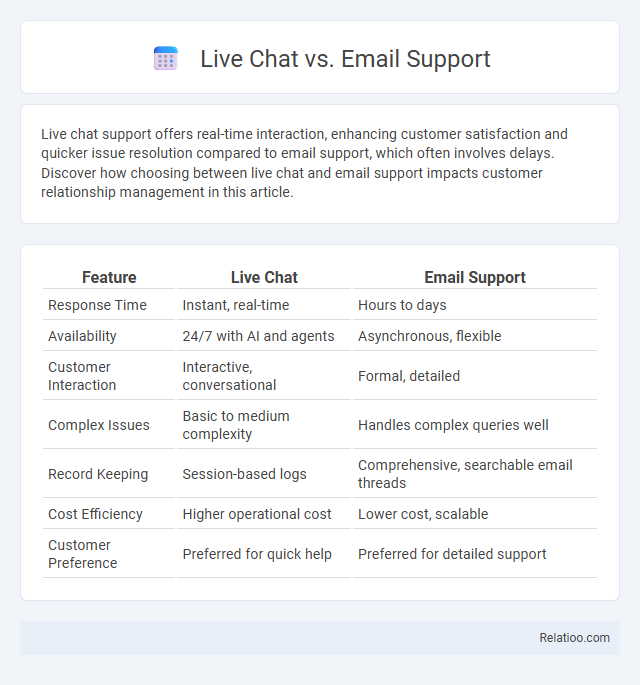Live chat support offers real-time interaction, enhancing customer satisfaction and quicker issue resolution compared to email support, which often involves delays. Discover how choosing between live chat and email support impacts customer relationship management in this article.
Table of Comparison
| Feature | Live Chat | Email Support |
|---|---|---|
| Response Time | Instant, real-time | Hours to days |
| Availability | 24/7 with AI and agents | Asynchronous, flexible |
| Customer Interaction | Interactive, conversational | Formal, detailed |
| Complex Issues | Basic to medium complexity | Handles complex queries well |
| Record Keeping | Session-based logs | Comprehensive, searchable email threads |
| Cost Efficiency | Higher operational cost | Lower cost, scalable |
| Customer Preference | Preferred for quick help | Preferred for detailed support |
Introduction to Live Chat and Email Support
Live chat support offers real-time, instant communication enabling quicker resolution of customer inquiries, enhancing user satisfaction and engagement. Email support facilitates detailed, asynchronous communication allowing comprehensive responses and easy record-keeping for complex issues. Both channels serve distinct roles in customer service, optimizing support efficiency and user experience based on urgency and issue complexity.
Key Differences Between Live Chat and Email Support
Live chat offers real-time interaction, enabling immediate problem resolution and enhancing customer satisfaction, while email support involves delayed responses that suit complex issues requiring detailed explanations. Your choice depends on urgency; live chat handles quick questions efficiently, whereas email support allows for comprehensive, documented communication. Both channels complement each other, balancing speed with depth in customer service strategies.
Response Time: Instant vs. Delayed Communication
Live chat offers instant response times, enabling real-time problem resolution and enhancing customer satisfaction with immediate solutions. Email support typically involves delayed communication, often requiring hours or even days for responses, which can slow down issue resolution. Choosing live chat over email support significantly improves response efficiency, crucial for businesses prioritizing quick customer interaction and retention.
Customer Experience and Satisfaction
Live chat support delivers instant responses, significantly enhancing customer experience by reducing wait times and increasing real-time engagement. Email support offers detailed, asynchronous communication ideal for complex issues but may delay resolution, impacting satisfaction. Combining live chat and email support maximizes customer satisfaction by balancing immediacy with thoroughness in addressing diverse needs.
Cost Efficiency of Live Chat vs. Email Support
Live chat support offers greater cost efficiency compared to email support by enabling agents to handle multiple customer inquiries simultaneously, reducing labor costs. Your business benefits from faster response times and higher customer satisfaction, which leads to increased retention and revenue. Email support, while effective for detailed queries, typically requires more time per interaction, increasing operational expenses.
Handling Complex Queries: Live Chat or Email?
Handling complex queries requires detailed explanations and thorough documentation, making email support ideal for your in-depth customer issues as it allows customers and agents to exchange comprehensive information at their own pace. Live chat provides real-time interaction, which is beneficial for resolving moderately complex problems quickly, but may struggle with extensive troubleshooting or multi-step solutions. Choosing between live chat and email depends on the complexity of the query and the customer's need for immediacy versus detail.
Scalability and Resource Management
Live chat offers real-time interaction with customers, enabling faster issue resolution and higher scalability through automation tools and chatbot integration. Email support allows for detailed, documented communication but may require more human resources as volume increases, potentially affecting response times. Your choice impacts resource management, where live chat supports efficient scalability, while email demands structured workflows to handle growing query volumes effectively.
Integration with Other Support Channels
Live chat offers real-time interaction, seamlessly integrating with CRM systems and social media platforms to provide instant support and personalized responses. Email support excels in managing detailed inquiries and long-form communication, often syncing with ticketing systems to track and escalate issues efficiently. Your choice should consider how well each channel connects with knowledge bases, phone support, and chatbots to ensure a unified customer service experience.
Security and Privacy Considerations
Live chat support offers real-time interaction but requires robust encryption protocols like SSL/TLS to safeguard sensitive user data from interception. Email support involves asynchronous communication, necessitating end-to-end encryption methods such as PGP or S/MIME to protect privacy and prevent unauthorized access. Standalone support systems must implement strict access controls, regular security audits, and compliance with data protection regulations like GDPR or CCPA to ensure comprehensive user data security and privacy.
Which Support Channel is Right for Your Business?
Choosing the right support channel depends on your business needs and customer expectations; live chat offers real-time interaction ideal for urgent issues, while email support provides detailed, asynchronous communication suitable for complex queries. Support channels must align with your resource availability, response time goals, and customer preferences to enhance satisfaction and operational efficiency. Understanding these differences empowers you to deliver personalized service and improve overall customer experience.

Infographic: Live Chat vs Email Support
 relatioo.com
relatioo.com